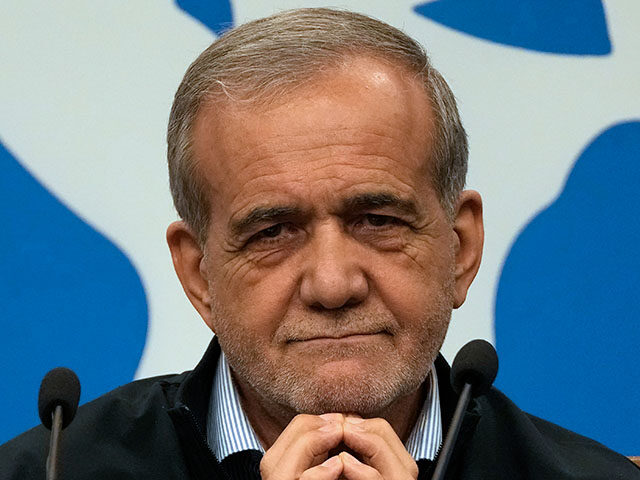Iran’s ‘Moderate’ President: Failed Missile Barrage on Israel a ‘Source of Pride’
 AP Photo/Vahid Salemi
AP Photo/Vahid Salemi
Iran’s “moderate” President Masoud Pezeshkian told a cabinet meeting on Wednesday his country’s failed missile barrage against Israel was a “great source of pride” that “proved the Israeli regime’s Iron Dome system is more fragile than glass.”
Pezeshkian said Iran demonstrated its “dignity and honor” with the attack, which he falsely claimed was executed in compliance with international law as a response to Israel eliminating the leader of Lebanese Hezbollah, Hassan Nasrallah.
In truth, Iran launched hundreds of missiles at Israel on Tuesday, but the vast majority of them were intercepted by Israel’s multi-layered defense system: the long-range exo-atmospheric Arrow ballistic missile interceptor, the medium-range David’s Sling system that has proven effective against the missiles launched by Iran’s terrorist proxy Hezbollah, and the more famous short-range Iron Dome that Pezeshkian referred to.
A few of Iran’s missiles did get through this time, a somewhat better showing that Iran managed with a completely ineffective missile barrage in April.
The Israel Air Force (IAF) said on Wednesday morning that some of its bases were hit by Iran’s ballistic missile attack, but only minor damage was inflicted upon office buildings and maintenance areas.The IAF rated all of the missile impacts as “ineffective” because they did not damage warplanes, munitions, or critical infrastructure, and operations resumed out of the Israeli airbases within a few hours.
Military analysts said Iran’s latest attack was a bit more effective than the April strike because it was launched with far less warning, and was conducted entirely with fast-moving ballistic missiles, while the April assault also involved slower-moving drones.
Iran’s advanced Fattah-1 and Kheybarshekan missiles have maneuverable warheads and employ solid fuel, which means they could be launched more rapidly, and it was easier for Iran to time its launches so the missiles all arrived in Israeli airspace together. The April attack made heavy use of liquid-fueled Emad ballistic missiles, which are slower to launch and easier to intercept.
Ankit Panda of the Carnegie Endowment for Peace told Reuters on Wednesday the new Iranian attack also took advantage of a “spent-down Israeli Arrow interceptor magazine,” meaning the longest-range Israeli system was able to intercept fewer Iranian missiles outside the atmosphere.
“If the Iranians launch another much larger attack, it is likely that more missiles will get through, particularly if ballistic missile attacks are coordinated with cruise missile and drone attacks – so I don’t think we’ve seen the maximum scale of attack by any means,” cautioned Malcolm Davis of the Australian Strategic Policy Institute (ASPI).
Source link

